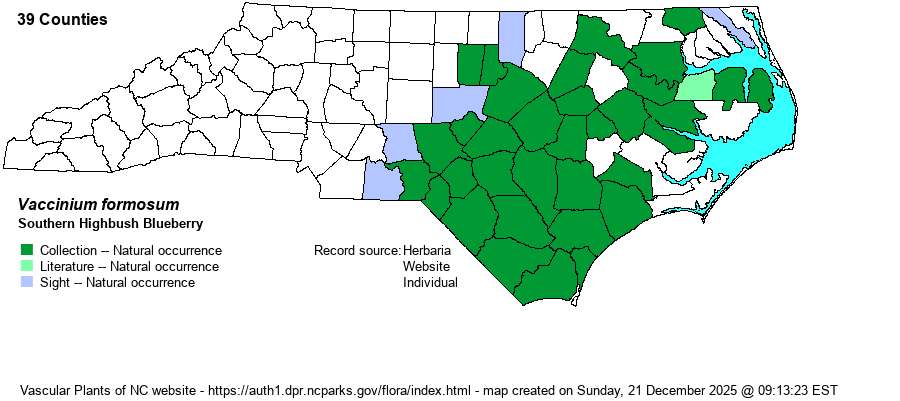| Section 6 » Order Ericales » Family Ericaceae |
Show/Hide Synonym
| taxonName | relationship | relatedTaxonName | relatedTaxonRefText | relComments |
|---|
|
|
|
|
| Vaccinium formosum | < | Vaccinium corymbosum | Gleason and Cronquist (1991) | | | Vaccinium formosum | < | Vaccinium corymbosum | Flora of North America (1993b, 1997, 2000, 2002a, 2002b, 2003a, 2004b, 2005, 2006a, 2006b, 2006c, 2007a, 2009, 2010) | | | Vaccinium formosum | < | Vaccinium corymbosum | Stevens et al. in Kubitzki (2004). Key based in part on Uttal (1987). | | | Vaccinium formosum | < | Vaccinium corymbosum | | | | Vaccinium formosum | < | Vaccinium corymbosum | Radford, Ahles, and Bell (1968) | | | Vaccinium formosum | < | Vaccinium corymbosum | Wunderlin & Hansen Flora of Florida (3) | | | Vaccinium formosum | < | Vaccinium corymbosum | Stevens et al. in Kubitzki (2004). Key based in part on Uttal (1987). | | | Vaccinium formosum | = | Vaccinium australe | Gleason (1952) | | | Vaccinium formosum | = | Vaccinium australe | Godfrey and Wooten (1979, 1981) | | | Vaccinium formosum | = | Vaccinium australe | Stevens et al. in Kubitzki (2004). Key based in part on Uttal (1987). | | | Vaccinium formosum | = | Cyanococcus virgatus | Small (1933, 1938) | , misapplied | | Source: Weakley's Flora |
|
| Author | Andrews | |
| Distribution | Occurs over most of the Coastal Plain and into the southeastern portion of the Piedmont. Scarce to absent in most of the far eastern counties near Albemarle and Pamlico sounds, and from parts of the northwestern Coastal Plain. In general, this is the “Vaccinium corymbosum” distribution in the Coastal Plain and eastern Piedmont from older references.
This species, recently split off from V. corymbosum, is limited essentially to the Atlantic Coastal Plain, ranging north to NJ, and south mostly to eastern GA. There are scattered records west to southern AL and northern FL. Thus, it is primarily a Carolina and VA species.
| |
| Abundance | In the southern half of the Coastal Plain, it is frequent to common; however, it is much less numerous in the northern and eastern counties, and rare toward the sounds. It is scarce to rare in the small Piedmont portion of the range. | |
| Habitat | This species occurs in quite wet ground where waters are not flowing, such as swamps (especially in blackwater swamps), beaver pond margins, boggy places, and depression ponds. |
| Phenology | Blooms from late February to May, mostly before or as the leaves are unfurling. Fruits from June to August. The fruits are considered to be the most flavorful of any native blueberry species, and it is the primary source of cultivated highbush blueberries. | |
| Identification | This is a medium to fairly tall deciduous shrub that usually grows to 6-12 feet high, often to about 10 feet tall. However, it has fairly typical elliptical to slightly ovate (widest below the middle) leaves, which grow to an average of 2-3 inches long. Many biologists may need to see the flowers to corroborate the identification, as it has white flowers that are a bit larger, typically 2/5-inch long (about 10 mm), than similar blueberries (especially V. fuscatum), and they tend to be more cylindrical in shape than urceolate (i.e., more parallel-sided than ball-shaped). In fact, other blueberries in Coastal Plain wetlands typically have flowers that are pink- or green-tinted and not pure white, except for the very similar V. caesariense. See that species account for separation from that species. Biologists will likely have most trouble separating it from V. fuscatum, which has darker green leaves above, narrower or more urceolate flowers (that can be pink-tinged), and black berries (as opposed to glaucous blue). In a current study of highbush blueberries (Chinquapin 29, Fall 2023) Devani Jolman of ODU in VA has documented many intermediates between formosum and fuscatum. These hybrids show intermediate values of leaf pubescence and flower size. So far, she believes that the parents are distinct species, and NCVP Taxon Editors will do the same. | |
| Taxonomic Comments | Until recently, most references had this taxon included within V. corymbosum. However, in recent years, the latter species has been determined to consist of multiple good species, and thus V. formosum has been split out as the primary Coastal Plain form, which generally has larger flowers and leaves than do the others in the group (i.e., V. corymbosum and V. caesariense).
| |
| Other Common Name(s) | Southern Blueberry, Swamp Highbush Blueberry | |
| State Rank | S5 | |
| Global Rank | G5 | |
| State Status | | |
| US Status | | |
| USACE-agcp | FAC link |
| USACE-emp | OBL link |

